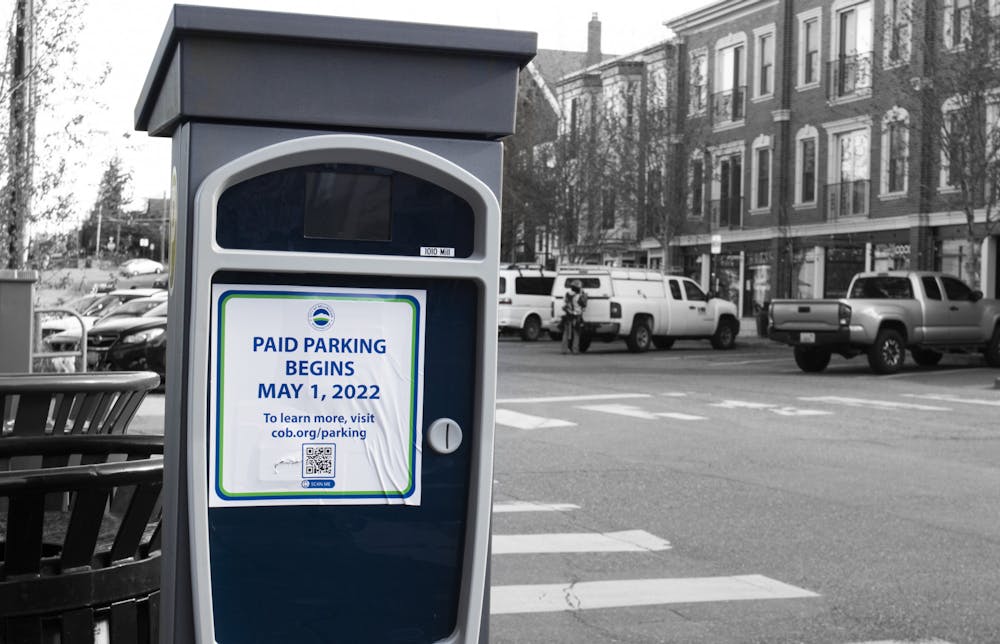Controversial changes came to downtown and Fairhaven Monday, May 2, as prices went up and parking spaces ceased to be free.
For the first time, people parking in Fairhaven will have to pay $1 an hour for a majority of on-street parking. In downtown, the price for parking will increase to $1 an hour from 75 cents.
“We are at the point now that justifies and demands the need for paid parking in Fairhaven,” said Eric Johnston, director of public works for the City of Bellingham.
Johnston said that the demand for parking spaces in downtown and Fairhaven have exceeded supply and have led to decisions to price the parking appropriately.
According to the Fairhaven Parking Task Force, parking availability has exceeded the 85% occupancy, which is the number they set as a threshold to determine when they need to manage parking demand with paid parking.
Originally, the Fairhaven Parking Management Plan was developed in 2014 by the Fairhaven Parking Task Force, which planned to implement paid parking in 2020. But the COVID-19 pandemic halted that move, Johnston said.
Where is the revenue going?
Ab McDonald has worked in Fairhaven for the last three years and lives three miles away from her job at The Old Independent.
She said the paid parking seems ridiculous and thinks it’s ambiguous as to where the money from the paid parking goes. It would make sense that the revenue would go back into the community.
Johnston said it does.
“We absolutely are not motivated to produce revenue for the city out of paid parking,” Johnston said.
The City of Bellingham’s FAQ page for the parking updates said the revenue will be reinvested to increase cleaning and landscaping and other town beautifications, support local businesses as well as go towards events like Downtown Sounds and other organizations.
According to the City of Bellingham FAQ page about the new parking changes, parking-related activities have generated about $2.2 million in revenue annually.
“Prior to 2020 and around 2019, we were spending to support the [Downtown Bellingham Partnership], using parking revenues at about $300,000 a year,” Johnston said, about 8%-10% of the total revenues. “We expect that to increase over time.”
The real cost of parking
In Fairhaven and downtown, parking permit areas will have a set amount of parking spots that will cost varying amounts monthly. Fairhaven’s, which will be on McKenzie Avenue between 10th and 11th streets, will cost $65 a month.
“[That] is expensive for most people who work in Fairhaven because we’re low-income,” McDonald said.
Johnston said they would reevaluate permit pricing after the first few months to make necessary supply and demand changes if necessary. He said the city will typically oversell discounted rate parking permits to 140% of the number of spaces available at the designated permit parking locations.
“There is no such thing as free parking,” Johnston said. “The cost of parking is paid by somebody, and charging the right price helps balance [open spaces] between all users who need that parking.”
Some might ask why the revenue produced from parking meters does not go towards building new parking lots.
Dr. Nicholas Zaferatos, professor of urban planning and sustainable development at the College of the Environment at Western, said there are a lot of hidden costs alongside the obvious expense of constructing the lots in the first place.
The implication of environmental impacts from big, paved surfaces disrupts local ecology when all of the water run-off from those surfaces carrying contaminants and pollutants has to get treated at sewage plants, Zaferatos said. That water that would have otherwise soaked up into the soil and replenished groundwater would then require taxpayers to pay more to treat that run-off.
“We like to think that, ‘oh it’s free parking because we don’t actually put money in a meter,’ but you pay it through absorbing it into taxes to cover expansions of sewage treatment plants,” Zaferatos said.
Johnston also said the city has policies that aim to discourage the reliance on single-occupancy vehicles and encourage the use of public transport or greener forms of transport indirectly netting less carbon dioxide output.
“Maybe it’ll push people to be more economical in getting to work or shopping by biking and being more environmentally friendly,” McDonald said. “But I think it’ll just make people mad.”
More parking space could be added
Zaferatos says there are still ways to create more parking spaces without more pavement.
“Get away from parallel parking,” Zaferatos said. “You can double the efficiency of parking space by having cars parked [diagonally].”
Zaferatos paints a picture of driving down Harris Avenue in downtown Fairhaven where traffic becomes notoriously slow. When the road feels narrow and parked cars could pull out unexpectedly, it has a positive side effect for an urban pedestrian zone.
“You’re driving 5 mph right?” Zaferatos said. “That’s called a traffic calming device.”
McDonald said that when the Fairhaven pay-to-park stations were first installed, a citizen, who was presumably not a fan of the new changes, destroyed the solar panel on the top of the machine and knocked the whole thing over.
“I'm going to try to continue biking more,” McDonald said.






